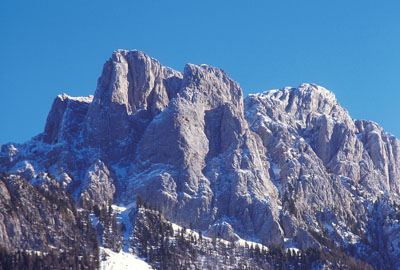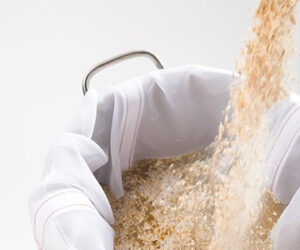High Elevation Brewing

Perhaps the answer lies in a desire to achieve a perfect product, rather than simply enjoying a good beer. For years I have brewed at high elevations, topping out at 9,200 feet in my mountain home, without making a single adjustment to my brewing process. And, while brewing at high elevations can cause some minor problems — the obvious factors being lower boiling temperatures, under utilization of hops and a lack of oxygen — the need to “correct” a batch is a matter of debate.
Hop utilization: It’s all in the boil
Hop under-utilization is the main concern surrounding high elevation brewing. Lower boiling temperatures at elevation can decrease hop alpha acid utilization and beer bitterness can be thrown off. Mark Garetz, author of “Using Hops, the Complete Guide to Hops for the Craft Brewer,” has developed a correction factor equation for hops based on elevation, yet he doesn’t put a lot of stake in needing adjustments. “My real world advice would be not to worry about it too much. This is still a pretty small difference,” Garetz says. “Usually (the brewer) won’t be able to tell the bitterness difference.”
John Arthur, a high-elevation homebrewer at his 8,000-foot elevation home, and owner of the What’s Brewin’ brewshop in Boulder, Colorado agrees: “(Bittering differences) can be overcome by increasing the hops, but it’s hardly even worth the effort. Even at the top of Mt. Whitney, it is such a minor adjustment that it is not even worth mentioning.”
But for those willing to take on even the most minute tweaking, Garetz’s adjustment factor is simple:
TF (Temperature Factor) = ((Elevation in feet/550)*0.02)+1
This formula can be used as the multiplier for the amount of bittering hops. In Denver (5,280 feet) the adjustment would be 1.19. For a recipe that normally called for one ounce of hops, a mile-high brewer would instead add 1.19 ounces.
Anthony Carestia, Brewmaster at Frisco, Colorado’s Backcountry Brewery, believes the need for hop adjustments can be overcome simply by maintaining a vigorous wort boil. It is his belief that under-utilization occurs because homebrewers might attempt to boil a wort larger than their stove can accommodate. This becomes more noteworthy at higher elevations where boiling points are lower. At sea level, water boils at 212 ºF (100 °C), but at 9,097 feet (Backcountry Brewery’s elevation) water boils at 195 ºF (91 °C). But, just because the water boils at a lower temperature, this doesn’t mean satisfactory hop extraction won’t take place.
“Our hop utilization is actually really good,” Carestia explains. “We have plenty of BTUs for (a steady, rapid) boil and as a result don’t have any hop utilization issues. It is true you boil more rapidly (at elevation), but that is not to say you can’t maintain higher temperatures. I used to brew at lower elevations and I actually have a better hop utilization here.”
Some breweries use pressurized boiling to increase wort temperature. For homebrewers, simply purchasing a 35,000 BTU cooker that runs on propane is an easier way to guarantee a good boil.
“You should always strive to have a strong boil,” Carestia states. “If that means reducing the batch size because limited (heating capabilities are) available, that is what you should do.”
This means at high elevation, without a big cooker, the only choice might be producing a high-concentration wort in a smaller-size brew kettle. The only downside is that a high concentration wort further reduces hop utilization, already an issue with high elevation brewing. High elevation, high concentration brewers concerned that this extra loss in utilization might be too much overall should consider balancing any loss with larger hop additions.
Cullen Dwyer, head brewer at Blue Corn Cafe and Brewery in Santa Fe, agrees. “A cooler boil will (slightly) lower your kettle alpha acid utilization, so you (could) add a few more hops to achieve the same bitterness you get at lower altitudes,” he explains, noting other hop factors come into play that can negate any adjustments. “There are lots of factors that can throw off your predicted bitterness, including age and freshness, length and vigor of boil, and density of the kettle wort. As long as you boil your beer vigorously, your alpha acid utilization should be just fine. Don’t worry about the altitude too much.”
The Mt. Whitney brewers’ goal was a high-altitude brewing world record. Hop utilization was calculated to be about one-third that at sea level and even with a boiling temperature of 186 ºF (86 °C), a small, two-gallon batch was brewed. This proved to be just the right size as “the boil was pretty vigorous given that we were at 14,500 feet and using one WhisperLite (stove) under a 3.5 gallon kettle,” wrote one of the brewers. And, “the resulting beer was deemed quite good.”
Lack of oxygen
The further from sea level, the thinner the air we breathe because of the lower oxygen content. Although the proportion of oxygen in the atmosphere always remains constant at 21%, as we go higher the “driving pressure” decreases. The driving pressure depends directly on the barometric pressure, and forces oxygen from the atmosphere into the capillaries of the lungs. Reduced driving pressure results in decreased saturation of oxygen in the blood. Of course, yeast do not breath, they do need oxygen.
The same pressures that affect our breathing at elevation will determine the amount of soluble oxygen available for the yeast. With this in mind, high elevation brewing can potentially increase difficulties for yeast, as oxygen solubility in the wort decreases with elevation gain.
“At sea level, brewers with lax aeration procedures can often skate by with good results, but don’t count on it (at elevation),” Dwyer interjects. “Yeast needs oxygen to build cell walls and reproduce before it can properly ferment your beer.”
“You would need to oxygenate (the wort) more at higher altitudes. (Oxygenating) more would make a lot of sense,” Chris White of White Labs agrees. Choosing suitable yeast, one with lower oxygen demands, may also help. According to White, White Labs California Ale and lager strains would probably perform best at higher elevations while the English strains — English, British, Irish Ale yeasts — tend to have a higher oxygen demand and might not perform as well.
Several methods of aerating the wort at high elevation include bubbling with an oxygen tank, adding an oxygenating stone or just shaking the carboy like hell. And while Carestia believes these methods are also useful, his preference is that a high pitching rate can overcome any altitude related oxygen deficiencies.
Increase the pitching rate
“There is a third less oxygen at this altitude, but it seems to be sufficient,” says Carestia. “I wouldn’t go out there and get a oxygenating stone or an oxygen tank. In my experience it is not necessary. You can get longer lags and yeast struggling to get through (fermentation), but I don’t think aeration is necessarily the issue.”
Athletes who train at elevation have more red blood cells than those who train at sea level. But yeast are unable to adapt to low oxygen environments the way the human body does. One way around this is to pitch more yeast. Carestia says, “I think the number one mistake of homebrewers is under pitching the proper amount of yeast.” There are several methods for building enough yeast to assure a strong pitching rate, including making a yeast starter and harvesting yeast from prior batches. Even at lower elevations, these techniques can be useful in decreasing lag times and ensuring an active fermentation.
So, brewers (generally) agree there are minor adjustments that can be made and small brewing process changes that will help any batch. Perhaps Arthur sums up the issues of high altitude brewing most succinctly. “High altitude brewing can easily be done,” he says, having produced hundreds of high elevation brews utilizing the same methods he would at lower elevations. “Really, there is not much different you need to be addressing. The only real difference is going to be with the hops, and it’s not much.” Rather, an attention to details – a good boil and a vibrant yeast culture – should be enough to ensure producing a quality homebrew at any elevation.
Recipe
High Altitude Pale Ale
Brewed at Blue Corn Café & BrewerySanta Fe, New Mexico, 7,000 ft.
5 gallons/19 L, extract with grains
OG = 1.056 FG = 1.014
IBU = 38 SRM = 15 ABV = 5.6%
At an O.G. of 1.056 and 38 IBUs, this dark amber pale ale could almost be called an I.P.A. (but not quite). The endemically American flavor and aroma of Centennial hops takes center stage on the palate. A variety of high-quality crystal malts form a complex, caramel back-drop that balances the brew. We ferment this with Wyeast Scottish ale yeast strain 1728. This strain helps bring out complex malty notes, but beware: it produces diacetyl! To avoid butterscotch flavors, pitch healthy yeast, ferment cool, and as fermentation winds down, move your fermenter to a warm spot for a few days for rapid maturation and diacetyl reduction.
If you low-landers should enjoy this beer in Santa Fe, New Mexico, at 7,000 feet, go easy: it’s got 5.6% alcohol by volume. Until your red blood cell count has adjusted to the thin air, your alcohol tolerance won’t be what you are used to!
Ingredients
3.3 lbs. (1.5 kg) unhopped amber liquid malt extract
3.8 lbs. (1.7 kg) light dried malt extract
8 oz. (0.23 kg) British crystal malt (40 °L)
8 oz. (0.23 kg) British crystal malt (80 °L)
6.4 AAU Centennial hops (75 min)(0.71 oz./20 g of 9% alpha acids)
4.5 AAU Centennial hops (30 min) (0.5 oz./14 g of 9% alpha acids)
0.4 oz. (11 g) Centennial hops (5 min)
0.4 oz. (11 g) Centennial hops (0 min)
Wyeast 1728 (Scottish Ale) yeast (from 1–2 quart/~1–2 L starter)
0.75 cups corn sugar (for priming)
Step by Step
Steep crushed crystal malts at 150 °F (66 °C) for 30–45 minutes. Add malt extract and bring wort to a boil. Boil for 90 minutes, adding hop charges at 75 minutes, 30 minutes, 5 minutes and knockout (when you turn the heat off). Cool, aerate vigorously and pitch yeast. Ferment and bottle with corn sugar.



